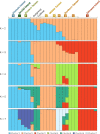Double migration of the endangered Tricyrtis formosana (Liliaceae) in Japan
- PMID: 38200076
- PMCID: PMC10781951
- DOI: 10.1038/s41598-024-51431-x
Double migration of the endangered Tricyrtis formosana (Liliaceae) in Japan
Abstract
The Ryukyu Islands of Japan are a biodiversity hotspot due to geographical and historical factors. Tricyrtis formosana is a perennial herbaceous plant that commonly found in Taiwan. But only a few populations have been identified in a limited habitat on Iriomote Island, while populations of unknown origin occur near human settlements in an area on the main island of Okinawa. To better understand these populations of the phylogenetic uniqueness and intrinsic vulnerability, we conducted comparative analyses including (1) phylogeny and population structure with MIG-seq data, (2) photosynthesis-related traits of plants grown under common conditions and (3) transcriptome analysis to detect deleterious variations. Results revealed that T. formosana was split into two clades by the congeners and that Iriomote and Okinawa populations independently derived from ancestral Taiwanese populations in each clade. Photosynthetic efficiency was lowest in the Iriomote population, followed by Okinawa and Taiwan. Transcriptome analysis showed that the Iriomote population accumulated more deleterious variations, suggesting intrinsic vulnerability. These results indicate that each T. formosana population in Japan is phylogenetically unique and has been independently dispersed from Taiwan, and that the Iriomote population presents a high conservation difficulty with a unique photosynthesis-related characteristic and a larger amount of deleterious variations.
© 2024. The Author(s).
Conflict of interest statement
The authors declare no competing interests.
Figures






Similar articles
-
Conservation units and the origin of planted individuals of an endangered endemic species Lobelia boninensis in the Ogasawara Islands.Sci Rep. 2024 Nov 9;14(1):27410. doi: 10.1038/s41598-024-78452-w. Sci Rep. 2024. PMID: 39521791 Free PMC article.
-
Small-scale population genetic structure of the sand bubbler crab Scopimera ryukyuensis in the Ryukyu Islands, Japan.Mol Biol Rep. 2020 Apr;47(4):2619-2626. doi: 10.1007/s11033-020-05350-5. Epub 2020 Mar 5. Mol Biol Rep. 2020. PMID: 32140958
-
Low genetic variation in the MHC class II DRB gene and MHC-linked microsatellites in endangered island populations of the leopard cat (Prionailurus bengalensis) in Japan.Immunogenetics. 2018 Feb;70(2):115-124. doi: 10.1007/s00251-017-1020-8. Epub 2017 Jul 9. Immunogenetics. 2018. PMID: 28689276
-
Chloroplast DNA phylogeography of Clintoniaudensis Trautv. & Mey. (Liliaceae) in East Asia.Mol Phylogenet Evol. 2010 May;55(2):721-32. doi: 10.1016/j.ympev.2010.02.010. Epub 2010 Feb 19. Mol Phylogenet Evol. 2010. PMID: 20172032 Review.
-
Population genetics of threatened wild plants in Japan.J Plant Res. 2003 Apr;116(2):169-74. doi: 10.1007/s10265-003-0083-9. Epub 2003 Mar 4. J Plant Res. 2003. PMID: 12736790 Review.
Cited by
-
Genomic analysis highlights the conservation significance of Torenia concolor (Linderniaceae) from the periphery of its distribution range.J Plant Res. 2025 Aug 19. doi: 10.1007/s10265-025-01659-z. Online ahead of print. J Plant Res. 2025. PMID: 40828360
-
Quaternary Radiation of Spring Ephemerals.Plant Environ Interact. 2025 Jan 24;6(1):e70021. doi: 10.1002/pei3.70021. eCollection 2025 Feb. Plant Environ Interact. 2025. PMID: 39867938 Free PMC article.
References
-
- Nakanishi H. Dispersal ecology of the maritime plants in the Ryukyu Islands. Japan. Ecol. Res. 1988;3:163–173. doi: 10.1007/BF02346937. - DOI
-
- Sugai K, et al. Extremely low genetic diversity of the northern limit populations of Nypa fruticans (Arecaceae) on Iriomote Island Japan. Conserv. Genet. 2015;17:221–228. doi: 10.1007/s10592-015-0773-6. - DOI
-
- Ota H. Geographic patterns of endemism and speciation in amphibians and reptiles of the Ryukyu Archipelago, Japan, with special reference to their paleogeographical implications. Res. Popul. Ecol. 1998;40:189–204. doi: 10.1007/BF02763404. - DOI
-
- Kamata H, Kodama K. Tectonics of an arc-arc junction: An example from Kyushu Island at the junction of the Southwest Japan Arc and the Ryukyu Arc. Tectonophysics. 1994;233:69–81. doi: 10.1016/0040-1951(94)90220-8. - DOI
-
- Gungor A, et al. Structural characteristics of the northern Okinawa Trough and adjacent areas from regional seismic reflection data: Geologic and tectonic implications. Tectonophysics. 2012;522–523:198–207. doi: 10.1016/j.tecto.2011.11.027. - DOI
MeSH terms
LinkOut - more resources
Full Text Sources
Research Materials

